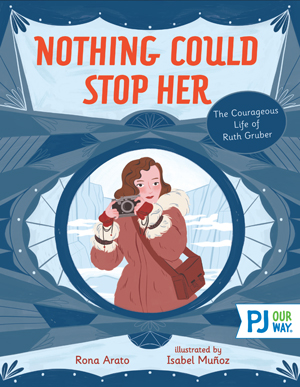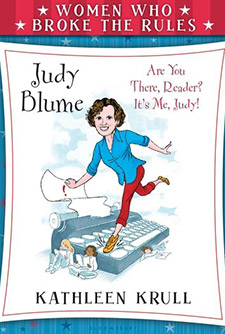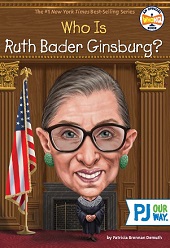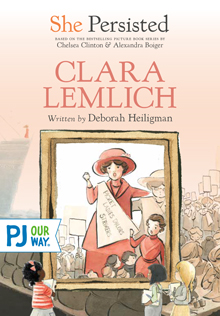Nothing Could Stop Her: The Courageous Life of Ruth Gruber
Which of these is true about the amazing Ruth Gruber?
- She hitchhiked alone to college because she couldn’t afford the ride.
- She became the youngest person in the world to get a PhD.
- She was the first foreign journalist to travel in Siberia.
- She lived to 105.
Average Rating
( hint: Login to leave a review! )
47 Reviews
Leave Review
What the Book Is About
Jewish Content & Values
Content Advisory
What the Book Is About
This short, illustrated biography explores the first three decades of Ruth Gruber’s life, from her childhood as the daughter of Russian-Jewish immigrants through the work she did on behalf of Holocaust refugees.
In the intervening years, Gruber focused on her education, entering high school at age 12, college at 15, and becoming the youngest person in the world to earn a doctorate (at the time). She was determined to become a writer, and after witnessing Hitler’s rise to power in Germany, Gruber researched and documented the experiences of women living under fascist and communist governments. Gruber was the first foreign correspondent to visit the Soviet Arctic as well as the Alaskan frontier.
In 1944, Gruber traveled with Holocaust refugees abord the USNS Henry Gibbons, and later lobbied for their rights while they were held in Oswego, NY.
Readers will be inspired by this story of a Jewish woman who shared the stories of people in need and fought for their rights at a time when women were expected to stay home and raise children.
In the intervening years, Gruber focused on her education, entering high school at age 12, college at 15, and becoming the youngest person in the world to earn a doctorate (at the time). She was determined to become a writer, and after witnessing Hitler’s rise to power in Germany, Gruber researched and documented the experiences of women living under fascist and communist governments. Gruber was the first foreign correspondent to visit the Soviet Arctic as well as the Alaskan frontier.
In 1944, Gruber traveled with Holocaust refugees abord the USNS Henry Gibbons, and later lobbied for their rights while they were held in Oswego, NY.
Readers will be inspired by this story of a Jewish woman who shared the stories of people in need and fought for their rights at a time when women were expected to stay home and raise children.
Jewish Content & Values
- Raised in a Jewish family and community, Ruth grew up speaking Yiddish and celebrating Shabbat, Rosh Hashanah, Yom Kippur, and Passover. Ruth often attended synagogue with her grandfather.
- Ruth’s parents and grandparents taught her the values of tikkun olam (repairing the world) and chesed (helping others). She stood up to antisemitism by investigating it and writing about it in popular newspapers in the United States.
- Ruth helped organize a Jewish wedding for two refugees at Oswego. When Ruth and the refugees first reached the United States, they recited the Shehecheyanu, a blessing of gratitude for a new or unusual experience. Ruth read The New Colossus (the poem on the base of the Statue of Liberty) by Emma Lazarus to the refugees and explained that it was written by a Jewish woman.
Content Advisory
While there are some references to the antisemitism that Gruber encountered during her time in Germany and the challenges that political prisoners faced while living in Siberia, there is nothing graphic or disturbing.
What the Book Is About
What the Book Is About
This short, illustrated biography explores the first three decades of Ruth Gruber’s life, from her childhood as the daughter of Russian-Jewish immigrants through the work she did on behalf of Holocaust refugees.
In the intervening years, Gruber focused on her education, entering high school at age 12, college at 15, and becoming the youngest person in the world to earn a doctorate (at the time). She was determined to become a writer, and after witnessing Hitler’s rise to power in Germany, Gruber researched and documented the experiences of women living under fascist and communist governments. Gruber was the first foreign correspondent to visit the Soviet Arctic as well as the Alaskan frontier.
In 1944, Gruber traveled with Holocaust refugees abord the USNS Henry Gibbons, and later lobbied for their rights while they were held in Oswego, NY.
Readers will be inspired by this story of a Jewish woman who shared the stories of people in need and fought for their rights at a time when women were expected to stay home and raise children.
In the intervening years, Gruber focused on her education, entering high school at age 12, college at 15, and becoming the youngest person in the world to earn a doctorate (at the time). She was determined to become a writer, and after witnessing Hitler’s rise to power in Germany, Gruber researched and documented the experiences of women living under fascist and communist governments. Gruber was the first foreign correspondent to visit the Soviet Arctic as well as the Alaskan frontier.
In 1944, Gruber traveled with Holocaust refugees abord the USNS Henry Gibbons, and later lobbied for their rights while they were held in Oswego, NY.
Readers will be inspired by this story of a Jewish woman who shared the stories of people in need and fought for their rights at a time when women were expected to stay home and raise children.
Jewish Content & Values
Jewish Content & Values
- Raised in a Jewish family and community, Ruth grew up speaking Yiddish and celebrating Shabbat, Rosh Hashanah, Yom Kippur, and Passover. Ruth often attended synagogue with her grandfather.
- Ruth’s parents and grandparents taught her the values of tikkun olam (repairing the world) and chesed (helping others). She stood up to antisemitism by investigating it and writing about it in popular newspapers in the United States.
- Ruth helped organize a Jewish wedding for two refugees at Oswego. When Ruth and the refugees first reached the United States, they recited the Shehecheyanu, a blessing of gratitude for a new or unusual experience. Ruth read The New Colossus (the poem on the base of the Statue of Liberty) by Emma Lazarus to the refugees and explained that it was written by a Jewish woman.
Content Advisory
Content Advisory
While there are some references to the antisemitism that Gruber encountered during her time in Germany and the challenges that political prisoners faced while living in Siberia, there is nothing graphic or disturbing.




